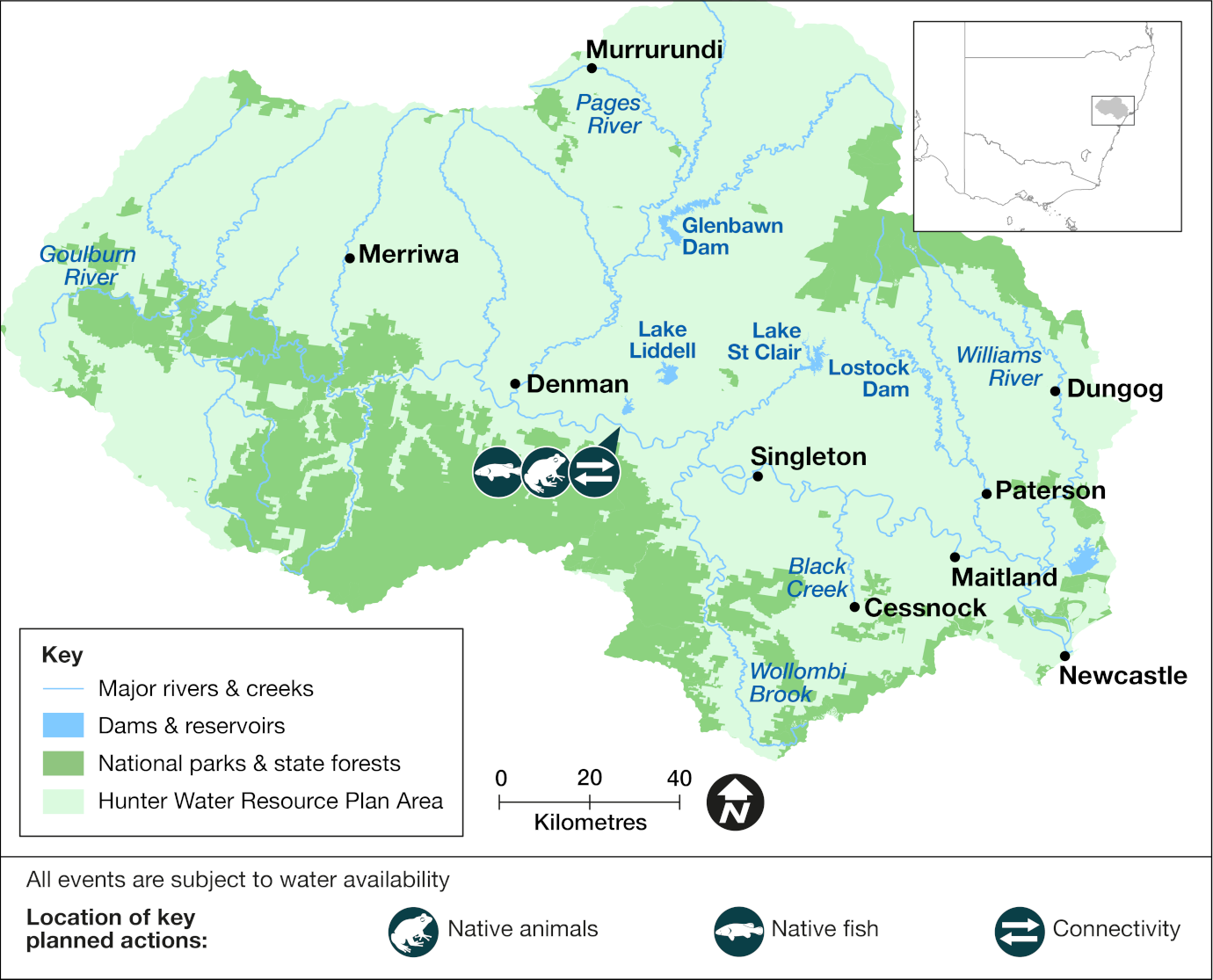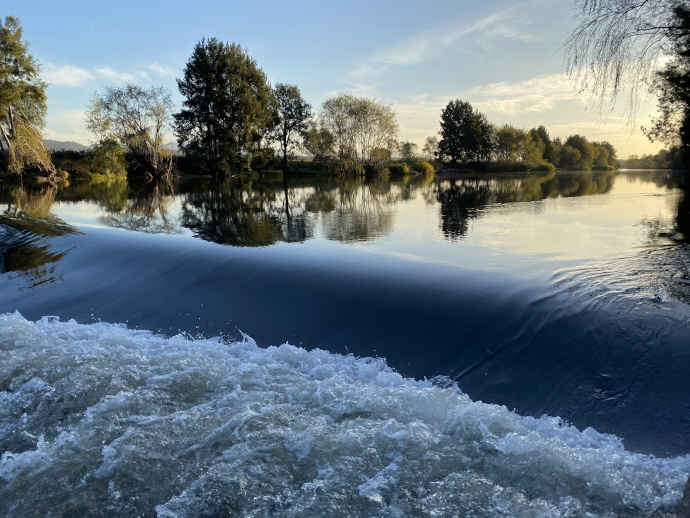Water that is allocated and managed specifically to improve the health of rivers, wetlands and floodplains is known as water for the environment.
Our local NSW environmental water management teams work with local communities, Aboriginal representatives, partner agencies, water users and other stakeholders to ensure the best use of water for the environment in each catchment, including how its use is prioritised.
Water for rivers and wetlands
In 2024–25, managed environmental flows will target a range of outcomes across the Hunter catchment, including:
- native fish migration
- Aboriginal water management priorities
- longitudinal river connectivity.
Wetter conditions observed in 2021–22 continued in 2022–23. Water for the environment was delivered during the 2022–23 water year to build on the benefits of wet conditions. Downstream migration of native fish and river connectivity was facilitated by water for the environment in 2022–23 and 2023–24.
In the year ahead, water managers will likely deliver flows to facilitate native fish migration, particularly around Liddell Weir. These flows will support native fish movement and dispersal opportunities throughout the system.
Management of water for the environment in the Hunter catchment will continue to focus on reconnecting the Hunter River. Water managers will likely deliver flows in winter 2025 and may deliver flows in spring 2024.
The environmental water allowance was reset to the full allowance on 1 July 2024.
Partnering with Aboriginal peoples
Water for Country is environmental water use planned by the department with Aboriginal peoples to achieve shared benefits for the environment and cultural places, values and/or interests.
We are working to support Aboriginal people to participate in environmental water planning and the use of the environmental water allowance in the Hunter catchment.
In 2024–25 we will:
- continue to build relationships with Aboriginal communities
- support Aboriginal people to include priorities in the Hunter–Paterson Long-Term Water Plan
- facilitate an environmental water release that shares benefits with Aboriginal people.
Weather and water forecast
As of June 2024, the El Niño–Southern Oscillation outlook is neutral. That is, neither La Niña nor El Niño conditions are favoured as oceanic and atmospheric indicators have returned to neutral levels. International climate models suggest neutral El Niño–Southern Oscillation conditions will persist through the southern winter, but there are some signs that La Niña conditions could form later in the 2024/25 water year.
The 3-month rainfall outlook for the Hunter is above the median from July to September, which may increase the current soil moisture and run-off efficiency within the catchment. Above-average temperatures are predicted from July to September 2024.
Water managers have prepared watering plans that consider a range of weather and water availability scenarios. This is known as resource availability scenario planning. Although dam levels remain high, a degree of uncertainty remains around resource availability.
Resource availability scenario
This table provides details about how we plan for different resource availability scenarios. Wet conditions are forecast for the Hunter catchment in 2024–25, which means water availability planning will follow the ‘wet’ scenario.
Current forecast: Wet to very wet
| Forecast | Main aim | Other aims |
|---|---|---|
| Very dry | Protect | Avoid critical loss Maintain key refuges Avoid catastrophic events |
| Dry | Maintain | Maintain river functioning Maintain key functions of high priority wetlands |
| Moderate | Recover | Improve ecological health and resilience Improve opportunities for plants and animals to breed, move and thrive |
| Wet to very wet | Enhance | Restore key floodplain and wetland linkages Enhance opportunities for plants and animals to breed, move and thrive |
Key planned actions
Native animals
Planned releases support a diversity of suitable habitats for water-dependent animals, including macroinvertebrates, frogs, platypus and turtles, by increasing resource availability and productivity and providing opportunities for breeding and recruitment. Inundation of connected ponds may provide breeding opportunities for frog species.
Native fish
Water managers will deliver flows to support native fish breeding and dispersal in the Hunter catchment. Releases in winter encourage downstream migration into the Hunter estuary for spawning, and water releases in spring and summer support the upstream migration of female adults and juvenile fish.
Connectivity
Water managers will look for opportunities to provide longitudinal connection along the Hunter River to encourage the dispersal of native fish into the system.
Map of proposed annual priority targets in the water resource plan area 2024–25

Map of the Hunter catchment area showing priority targets for environmental water to be delivered to in 2024-25
The Department of Climate Change, Energy, the Environment and Water delivers water for the environment where and when it is needed to support the health and resilience of rivers and wetlands. We use the best available science, management expertise and experience to manage water across the landscape. This statement of annual priorities identifies the waterways and wetlands that are likely to receive water.
Our decision-making process considers:
- expected availability of water in the coming year
- conditions of the previous year
- current health of the plants and animals in these ecosystems.
Water for the environment delivers benefits for communities, rivers, wetlands and wildlife across New South Wales.
Healthy, connected rivers and floodplains are a focus for tourism, fishing, recreation and relaxation. Rivers carry water to our homes, schools, farms and businesses, and along the way, support countless species including native fish, waterbirds, frogs, plants and more. Rivers and wetlands have great cultural and spiritual significance for Aboriginal people.
Water for the environment is a critical tool to maintain and enhance the rivers, wetlands and wildlife we all love.
Working with communities
Local communities are at the heart of everything we do.
In catchments that have community-based environmental water advisory groups, our water management teams consult with them regularly.
Environmental water advisory group members include local landholders, recreational fishers, Aboriginal people and local government representatives. Their advice informs the decisions made by our local environmental water management teams.
The department is in the process of developing an environmental water advisory group for the Hunter–Paterson region.
The Department of Climate Change, Energy, the Environment and Water works with partner agencies to manage environmental water in the catchment.
Planned environmental water
| Source | Maximum volume available (megalitres) | Volume expected 1 July under current conditions (megalitres) |
|---|---|---|
| Hunter environmental water allowance | 20,000 | 20,000 |
| Paterson environmental water allowance | 2,000 | 2,000 |
Notes: This is an indicative summary of expected volumes to be available. For further detail and information on available volumes you can contact the region via the Department of Climate Change, Energy, the Environment and Water on 1300 361 967.
1 gigalitre = 1000 megalitres; 2.5 megalitre = 1 Olympic swimming pool.
Water for the environment has been delivering outcomes for rivers, wetlands and wildlife for 30 years.
We deliver flows that:
- trigger native fish to breed and move
- support waterbirds to nest and feed
- connect rivers and floodplains
- water forests and floodplains
- allow plants to grow, flower and set seed
- create refuge during droughts
- enhance outcomes during wetter times
- release vital nutrients from the floodplain floor that underpin the aquatic food web.
It’s habitat restoration on a landscape scale.

Liddell Weir on the Hunter River during a 2023 environmental water release